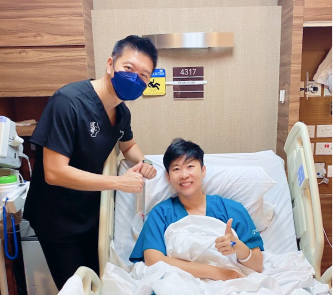Hand and Wrist Injury in Singapore
The hand and wrist are composed of bones, ligaments, muscles and tendons working together to allow for dexterity, stability and movement. Both parts are constantly used in day-to-day life, as well as sports, making hand and wrist injuries very common.
Common causes of a hand and wrist injury in Singapore include blunt trauma and accidents, which lead to fractures, sprains, dislocations and broken bones. For athletes who regularly engage in high-intensity sporting activities, their hand and wrist injuries are most likely due to overuse, over-exertion, accidents and poor form.
Hand and wrist injuries in Singapore may present with differing signs and symptoms, depending on the specific type and severity of the injury. Common signs and symptoms, however, include:
- Pain or stiffness
- Swelling
- Localised warmth and tenderness around the injury
- Numbness
- Weakness
- Limited range of motion or loss of motion
- Bruising
Some of the most common conditions affecting the hand and wrist are:
- Sprain and strains – Many hand and wrist injuries are caused by sprains whereby ligaments that connect two bones become stretched or torn. Meanwhile, strains occur when muscles and tendons in the hand or wrist become stretched or torn.
- Carpal tunnel syndrome – This happens when there is excess pressure on the median nerve, which is the nerve responsible for controlling movement in one’s fingers. Numbness, weakness and tingling are some of the common symptoms.
- De Quervain’s tendinopathy – This condition arises when tendons or the tendon sheath (synovial lining) in the hand and wrist becomes inflamed. Symptoms include swelling, pain and stiffness.
- Osteoarthritis – This is the most common type of arthritis that occurs when the cartilage in the hand and wrist wears down. Osteoarthritis in the hand usually begins in the area where the thumb meets the wrist.
- Rheumatoid arthritis – This is an autoimmune condition in which the body’s immune system mistakenly attacks healthy joints, causing pain, stiffness and swelling. It usually starts in the hand and wrist and can lead to bone deformity and degradation if not treated promptly.
Aside from physical exams, orthopaedic surgeons may conduct the following tests to diagnose hand and wrist injuries:
- Imaging tests – X-rays, CT scans, MRIs and ultrasounds may be done to clearly visualise the bone and tissues in the hands and wrists, and identify abnormalities
- Arthroscopy – This involves inserting a light-and-camera-equipped instrument through a small incision on the hand or wrist. In some cases, arthroscopy may also be used to repair or remove damaged tissues.
- Electromyography and nerve conduction studies (NCS) – Both tests are done to measure electrical activity in the hand or wrist, particularly how fast electrical impulses travel down nerves.
This depends on the type and severity of the injury. For mild to moderate injuries, the RICE (rest, ice, compression, elevation) method is recommended, alongside over-the-counter pain relievers. Physiotherapy also plays a key role in strengthening the muscles and restoring movement and flexibility in these areas. For more severe injuries where conservative treatments prove to be insufficient, surgery may be deemed necessary.
The likelihood of sustaining hand and wrist injuries can be reduced by adopting the following tips:
- Establishing breaks when doing tasks that are repetitive in nature (e.g. lifting, playing instruments, sports that involve a lot of throwing and catching motions)
- Be careful when gripping, especially when using the thumb and index finger
- Avoid smoking, as it is a risk factor for carpal tunnel syndrome
- Maintain a good posture (e.g. using an ergonomic mouse or keyboard)
The Bone and Joint Centre is well-equipped to treat wide range of hand and wrist conditions, including:
- Carpal tunnel syndrome
- Trigger finger
- De Quervain’s tenosynovitis
- Nail bed injury
- Peripheral nerve injury and repair
- Nerve compressions
- Tendon injuries
- Fingertip amputations and local flaps
- Fractures
- Arthritis
- Ligament injuries
- Lumps and bumps (e.g., ganglions and cysts)
Considering that the hands and wrists are two of the body’s most used parts, any pain or problem that affects their function should be checked out by a doctor. For consultations, contact The Bone & Joint Centre – a Singapore orthopaedic clinic specialising in the diagnosis and treatment of all musculoskeletal problems, including hand and wrist conditions.
FRCSEd (Orth), FAMS
Dr Kevin Koo is a skilled hand and wrist surgeon with over 20 years of experience in orthopaedic surgery. Dr Koo completed a fellowship at St. Mary's and Charing Cross Hospitals, Imperial College Healthcare in London, UK, where he worked with internationally recognised orthopaedic surgeons and treated professional athletes and dancers.
His practice interests include foot and ankle surgery, joint replacements, sports and minimally invasive surgery. He has presented extensively at international, regional as well as local conferences including the prestigious American Academy of Orthopaedic Surgeons (AAOS) as well as the British Society for Surgery of the Hand (BSSH) Annual Scientific Meetings.



| Tel. | : +65 6970 5905 |
| Fax | : +65 6970 5906 |
| Mobile | : +65 9898 7781 |
| : hello@bjc.sg, drkevinkoo@bjc.sg |
| Mon - FriMonday -Friday | : 8:30am to 5:30pm |
| Sat, Sun and PHSaturday, Sunday & PH | : Closed |
Well-being: Our Focus at
The Bone & Joint Centre.
We know that getting back to the activities you love is what truly matters. We are committed to providing high-quality, compassionate care to help you regain the ability to live life to the fullest.
Call us at 9898 7781 or fill out the form below and we will
get in touch as soon as possible.
| Tel. | : +65 6970 5905 |
| Fax | : +65 6970 5906 |
| Mobile | : +65 9898 7781 |
| : hello@bjc.sg, drkevinkoo@bjc.sg |
| Mon - FriMonday -Friday | : 8:30am to 5:30pm |
| Sat, Sun and PHSaturday, Sunday & PH | : Closed |





